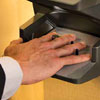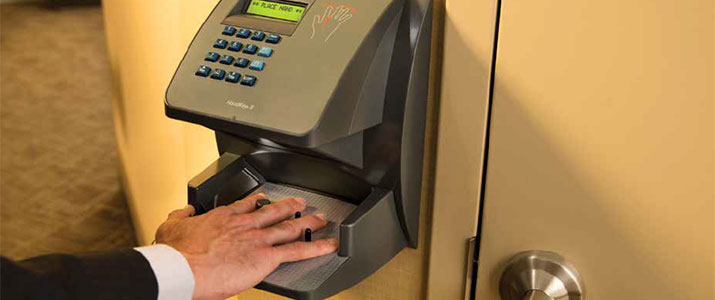
Finding Biometrics
Through several stages of card technologies, organizations still didn’t know who was carrying the card
- By Emily Flink
- Dec 31, 2013
 For more than 20 years, biometric hand geometry systems have been
providing the highest level of security, access control and convenience
in a wide range of applications all over the world. These devices
are easy to install, easy to maintain and increase productivity
while reducing the risk associated with lost or stolen credentials;
therefore, biometrics adds another layer of protection that cards cannot.
For more than 20 years, biometric hand geometry systems have been
providing the highest level of security, access control and convenience
in a wide range of applications all over the world. These devices
are easy to install, easy to maintain and increase productivity
while reducing the risk associated with lost or stolen credentials;
therefore, biometrics adds another layer of protection that cards cannot.
For instance, once a badge is lost or stolen, during the time from when the badge
is misplaced to the time that it is subsequently reported, that badge is still enrolled
and active in the access control system. Biometrics eliminates this highly-probable,
potential breach of security because by adding a biometric to a presently-installed,
card-based access control system, a badge alone cannot be used to gain access.
And, for multi-factor authentication, if the facility uses hand geometry technology,
both the badge and the person’s hand are required.
Biometrics is flexible. A HandReader can be used as a standalone device at a
single door or can be connected to the overall access control system for a comprehensive
security solution. Biometrics is well suited to a host of applications—providing
organizations with increased access control standards and user convenience.
From military installations to checking in at a hair salon, biometrics is everywhere.
Building construction. With the building of the Venetian Macao, the anchor
of a Las Vegas-style strip in Asia, HandReaders solved a crucial problem for the
contractors.
Protecting projects from theft and keeping people from getting hurt on construction
sites are always a top concern. In Macao, strict labor and safety laws that
prevent illegal workers and workers without safety training from entering construction
sites make strict access control even more urgent. General contractors
who violate these laws receive heavy penalties when they are caught. Thus, for
the Macao project, Solution Expert Technology of Hong Kong implemented a
biometric-based system using 90 HandReaders.
Biometric hand geometry technology helped to give quick access to authorized
workers and accurately deny entry to people who should not be on site. With the
HandReaders, a worker’s permit and safety training records, along with expiration
dates, were entered into a database that not only verified an employee’s identity,
but instantly checked to see if that employee was authorized to be there.
Commercial buildings and campuses. At individual buildings as well as corporate
campuses, IT rooms, HVAC rooms, conference centers and at many facilities’
front entrances, biometric readers track and control access to specialized, highasset,
secure areas.
At a 250-acre Midwest industrial campus, those seeking access to the manufacturing
plant, as well as other facilities, must present their hands for a biometric
scan on a Schlage HandKey II reader to verify identification before admittance to
the facility. Sales people, approved contractors and technical consultants also have
access via the HandReaders, reducing staff approvals for each visit.
Critical infrastructure. Many facilities
today use cards and readers to grant
door access, but that’s simply not good
enough for high-security locales that
cannot afford a breach. It’s important to
remember that the only verification that
a card can produce is that the card can
enter. These facilities need to know who
is carrying the card, and it is vitally important
that only those that are authorized
to enter do so.
Biometrics provides that additional
layer of security—you need to be yourself,
not what you are carrying.
Data centers. Typically larger installations,
such as Equinix, use biometric
Schlage HandKey II’s at the facility
entrance, on the security corridor and
on the individual customer areas of
their data centers. Administration of
the system includes features tailored for
this type of application, including import/
export and remote enrollment for
multi-facility management and expiring
privileges for temporary access.
HandReaders give data centers a
“Fort Knox” feel. This approach is comforting
to clients while heightened security
puts employees more on guard and
generates a heightened state of alert.
Financial institutions. With biometric
HandReaders, banks, savings and loans,
and credit unions can provide access control
for safe deposit vaults without the
need for bank staff to accompany the
customer in and out of the vault. Located
just outside the steel door leading to the
boxes, members no longer need to wait in
line for a service representative to admit
them into the safe deposit box room.
When a member wants access to
her safe deposit box, she enters her
four-digit PIN and places her hand in
the reader, which compares her hand’s
length, width, thickness and surface
area with the template stored in the
HandKey II. This simple process takes
approximately one second. When a
match occurs, the door opens, allowing
the member to enter, where she can access
her safe deposit box.
Healthcare facilities. Using cards
and PIN codes together often creates
many problems at hospitals. Physicians
are unlikely to always have their badges.
With the HandReader, all they need
to remember is an issued PIN code.
At a major hospital in the southern
United States, 39 HandKey terminals
heighten security for patients and 3,500
employees on its 61-acre main hospital
campus. Schlage HandKey terminals
are used in the birth center, IT data center,
other major IT areas, the operating
rooms and the emergency department.
From a security standpoint, hand
geometry readers provide secure,
tracked access that protects staff, patients,
visitors and records in highlysecured
hospital areas such as the
pharmacy, patient records, labs and
surgery rooms.
Higher Education. There is probably
no venue where biometrics is more visible
than on college campuses. Data
from independent research, Effective
Management of Safe & Secure Openings
& Identities, showed that 10 percent of
colleges are using biometrics, though it
is used more by city and urban colleges
than rural schools.
Besides resident halls, biometrics are
popular at dining halls where they limit
access to students who have paid for meal plans and at computer labs where
only those authorized to enter can
do so, protecting sensitive equipment
and information. However, one of the
most popular venues for biometrics on
an education campus is recreational
facilities. Students continually forget
to bring their cards when planning to
workout. Plus, the recreational facility
doesn’t face the problem of students
transferring an ID card to a friend. The
University of California (UC)-Irvine,
with 22,000 students, is an example.
“The number one suggestion from
our members was eliminating the need
for ID cards,” said Jill Schindele, director
of campus recreation at UC-Irvine.
“We took their suggestions seriously
and feel that hand geometry is the fastest
and most efficient alternative to
identification cards.”
With biometrics, students throughout
the nation receive added security and the
convenience of not worrying about lost,
stolen or borrowed credentials.
Transportation hubs. For more
than 20 years, employees and passengers
at San Francisco International
Airport (SFO) have been comforted
by the knowledge that their safety is
in good hands.
As the nation’s 10th busiest airport,
SFO employs biometric HandReaders
to secure its air operations area (AOA),
allowing access to authorized persons
only. The readers secure more than 180
doors and verify the identity of more
than 18,000 employees.
The use of biometrics at SFO is fully
integrated into the airport’s overall access
control system.
Utilities. HandReaders are installed
on the doors of major North American
nuclear power plants to ensure only authorized
users can enter. For instance,
at a Canadian nuclear power plant,
every employee, even the chairman
himself, as well as visitors to the facility,
must enroll on the HandKey to be
admitted into the site.
Hand geometry was selected for its
ease of use, reliability and high accuracy.
Also, versus other biometric options,
like fingerprint and iris, the plant
found that hand geometry technology
was the easiest to introduce to their employees.
In fact, at implementation, the
employee response was excellent.
A New Definition of Security
What was once acceptable for security
is now being questioned. Since the objective
of any access control system is
to let authorized people into specific
places, only the use of a biometric device
meets this goal.
Systems that use PINs only require
individuals to know a specific number
to gain entry, but who actually enters
the code cannot be determined. HandReaders,
on the other hand, verify
who a person is in a convenient and
reliable manner.
This article originally appeared in the January 2014 issue of Security Today.